
Viola beckwithii, known commonly as the Great Basin violet, Beckwith's violet, and sagebrush pansy, is a species of violet native to the western United States. It is an early-flowering plant of sagebrush habitats in the Great Basin region.
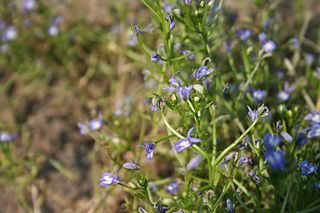
Downingia elegans is a species of flowering plants in the bellflower family known by the common names elegant calicoflower and Californian lobelia. This showy wildflower is native to western North America from California to British Columbia, where it is a resident of meadows and vernal pool ecosystems. This annual grows on a branching erect stem with many pointed leaves. At the top of each stem branch is one or more flowers, each one half to two centimeters wide. The tubular flower has two long, narrow, pointed upper lobes which are generally rich purple. The lower lip is fused into one three-lobed surface, which is purple with a large blotch of white in the center. The lobes may be quite pointed. There is sometimes some yellow coloration near the mouth of the tube.

Calochortus monophyllus is a North American species of flowering plants in the lily family known by the common name yellow star-tulip.

Caulanthus cooperi is a species of flowering plant in the family Brassicaceae known by the common name Cooper's wild cabbage. It is native to the southwestern United States and Baja California, where it is a common plant in a number of open, sandy habitats. This annual herb produces a slender, somewhat twisted stem with widely lance-shaped to oblong leaves clasping it. The flower has a rounded or urn-shaped coat of pinkish or pale greenish sepals enclosing light yellow or pale purple petals. The fruit is a straight or curving silique several centimeters long.

Ribes montigenum is a species of currant known by the common names mountain gooseberry, alpine prickly currant, western prickly gooseberry, and gooseberry currant. It is native to western North America from Washington south to California and east as far as the Rocky Mountains, where it grows in high mountain habitat types in subalpine and alpine climates, such as forests and talus. It is a spreading shrub growing up to 1.5 meters tall, the branching stems covered in prickles and hairs and bearing 1 to 5 sharp spines at intervals.

Ribes velutinum is a species of currant known by the common name desert gooseberry.

Selaginella cinerascens is a species of spikemoss known by the common names mesa spikemoss, gray spikemoss, and ashy spikemoss. It is native to Baja California as well as some locations just north of the border in San Diego County, California. It grows in dry habitat, often on clay soil, both in open areas and in the shade of larger plants. This lycophyte forms mats of spreading, forking stems up to 18 centimeters long. The plant is often gray or brown in color, forming a dull-colored carpet on the substrate. The linear or lance-shaped leaves are 1 to 3 millimeters long and lack bristles at the tips. The leaves are green when new or moist. They are flattened to the stem or stick out just a little. The strobili borne at the leaf bases are yellow in color and no more than 4 to 5 millimeters long.
Packera ganderi is a rare species of flowering plant in the aster family known by the common name Gander's ragwort. It is endemic to southern California, where it is known from a few occurrences in San Diego and Riverside Counties.
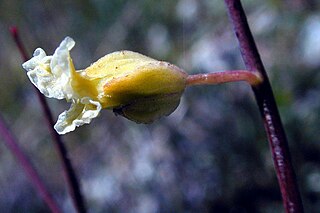
Streptanthus glandulosus is a species of flowering plant in the mustard family known by the common name bristly jewelflower. It is native to California and southwestern Oregon, where it grows in many types of habitat, including grassland, chaparral, and woodlands. Genetic and other analyses indicate that it is a species complex with ten subspecies which evolved as populations were isolated from each other. The complex includes subspecies previously considered separate species, such as the rare Tiburon jewelflower endemic to the San Francisco Bay Area. Plants in the complex are variable. In general they are annual herbs growing 10 centimeters to over a meter in height. They may be hairless to hairy to bristly. The ephemeral basal leaves have blades borne on winged petioles. Leaves higher on the stem are linear to lance-shaped and clasp the stem at their bases. Flowers occur at intervals along the upper stem. Each flower has an urn-shaped calyx of sepals one half to over one centimeter long which can be most any color from white to yellowish to pink or purple to nearly black. Purple, white, or purple-veined white petals emerge from the tip. The fruit is a straight or curving silique up to 11 centimeters long.
Streptanthus howellii is an uncommon species of flowering plant in the mustard family known by the common name Howell's jewelflower. It is endemic to the Klamath Mountains of southern Oregon and northern California. It grows in mountain forests on serpentine soils. It is a perennial herb producing a hairless, often waxy-textured stem up to 70 or 80 centimeters in maximum length. It is generally unbranched. The ephemeral basal leaves have fleshy oval blades with smooth or toothed edges, borne on petioles. Leaves farther up the stem are similar but smaller and narrower, with shorter petioles or none. They do not clasp the stem. Flowers occur at intervals along the upper stem. Each has a calyx of purple sepals under a centimeter long with purple-tipped yellow petals emerging from the tip. The fruit is a thin, smooth, curved silique up to 12 centimeters long.
Viola aurea is a species of violet known by the common names golden violet and bright yellow violet. It is native to eastern California and western Nevada, where it is known from scattered occurrences in various types of dry habitat such as the slopes of desert mountains. This herb grows from a tough taproot and produces a woolly-haired stem up to about 13 centimeters tall. The leaves have toothed or wrinkled, rounded or oval blades borne on petioles. They are coated in thick, white hairs. A solitary flower is borne on an upright stem. It has five yellow petals, the lowest one marked with brown veining and the upper pair tinged with brown or purple on the outer surface.

Viola bakeri is a species of violet known by the common name Baker's violet. It is native to the Western United States, from Washington and Oregon, to the mountains of northern Nevada, and in California to the southern High Sierra Nevada.
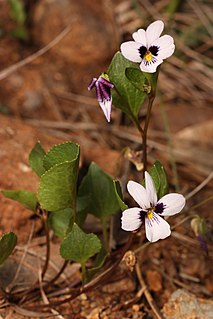
Viola cuneata is a species of violet known by the common name wedgeleaf violet. It is native to southwestern Oregon and northwestern California, where it occurs in the forests of the coastal mountain ranges, often on serpentine soils. This rhizomatous herb produces a hairless stem reaching a maximum height of a few centimeters to around 25 centimeters. The basal leaves have purple-veined green oval, rounded, or wedge-shaped blades borne on long petioles. Leaves higher on the stem are smaller. A solitary flower is borne on a very slender upright stem. It has five white petals with yellowish bases, the lateral two and usually upper two with purple spots. Their outer surfaces may be deep purple to red, and the lowest three are generally marked with purple veining.

Viola douglasii is a species of violet known by the common name Douglas' violet, or Douglas' golden violet. It is native to western North America from Oregon through California and into Baja California, where it grows in seasonally moist habitat, often on serpentine soils. This rhizomatous herb produces a cluster of erect stems just a few centimeters in length to about 20 centimeters in maximum height. The leaf blades are deeply dissected into several narrow lobes or compound, made up of leaflets, and borne on long petioles. They are hairless to softly hairy in texture. A solitary flower is borne on a long, upright stem. It has five bright or deep yellow petals with brown veining and brown outer surfaces. The largest lowest petal may be over 2 centimeters in length.
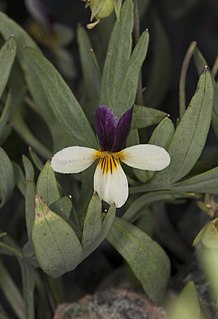
Viola hallii is a species of violet known by the common names Oregon violet and Hall's violet. It is native to southwestern Oregon and northwestern California, where it occurs in open areas in the forests and chaparral of the coastal mountain ranges, on gravelly soils, often of serpentine origin. This rhizomatous herb produces a cluster of hairless stems reaching a maximum height of about 22 centimeters. The leaves are each divided into three fleshy leaflets which are deeply divided into lance-shaped lobes and borne on short petioles, very similar to Viola beckwithii. A solitary flower is borne on a long, upright stem. It has five petals, the lower three cream-colored with yellow bases and red veining, and the upper two dark red or purplish.

Viola lobata is a species of violet known by the common name pine violet. It is native to western North America from southern Oregon through California and into northern Baja California, where it occurs in mountain ranges and foothills. It grows in woodlands and other habitat. This rhizomatous herb produces an erect stem a few centimeters tall or growing to nearly half a meter in maximum height. The leaves have variously shaped blades borne on long petioles. The blades are 5 to 15 centimeters wide and may be hairless, hairy, or waxy in texture. The leaf blades are often divided into narrow lobes or dissected into small segments. The shape of the leaf blade differentiates the two subspecies; ssp. lobata has dissected leaves and ssp. integrifolia has entire or toothed blades. A solitary flower is borne on a long, upright stem. It has five yellow petals, all five or just the lower three with purple or brown veining and the upper two stained with purple or brown on the outer surfaces.

Viola ocellata is a species of violet known by the common names pinto violet, two-eyed violet, and western heart's ease. It is native to southern Oregon and northern and central California, where it occurs in the coastal foothills and mountain ranges. It sometimes grows in serpentine soils and in quicksilver mines.
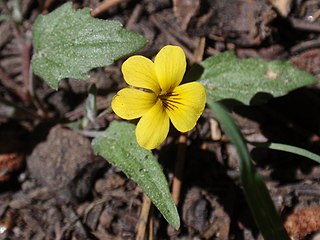
Viola pinetorum is a species of violet known by the common names goosefoot violet, goosefoot yellow violet, gray-leaved violet, or mountain yellow violet. It is endemic to California, where it grows in mountain ranges throughout the state. It occurs in various types of mountain habitat, including forests and talus. This herb grows from a tough taproot and produces an erect or decumbent stem up to about 22 centimeters long. The leaves are linear to oval in shape with pointed tips and toothed edges. The longest ones reach 15 to 20 centimeters in length. A solitary flower is borne on a long, upright stem. It has five yellow petals, the lowest three veined with brownish purple, and the upper two with brownish purple coloring on the outer surfaces.

Viola sheltonii is a species of violet known by the common names Shelton's violet and fan violet. It is native to the western United States where it occurs in forests, woodlands, and chaparral habitat. This rhizomatous herb produces a cluster of stems up to about 27 centimeters tall. The fan-like leaf blades are each divided into leaflets which are deeply dissected into narrow segments, the whole blade borne on a long petiole. A solitary flower is borne on a long, upright stem. It has five yellow petals, the lower three veined with purple-brown and the upper two stained purple-brown on the outer surfaces.
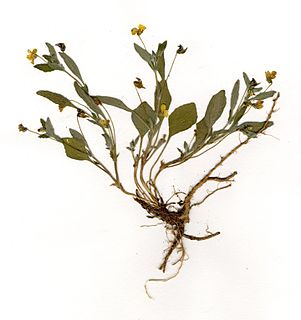
Viola tomentosa is a species of violet known by the common names feltleaf violet and woolly violet. It is endemic to the central Sierra Nevada of California, where it occurs in various types of dry mountain forest habitat. This small herb grows from a deep taproot, reaching a maximum height of 5 to 10 centimeters. The herbage is coated with woolly hairs. The leaves have oval blades borne on petioles a few centimeters long. A solitary flower is borne on a short upright stem. It is under a centimeter long with five yellow petals. The lower three petals are veined with dark brown and the upper two are stained brown or purplish on the back sides.

















